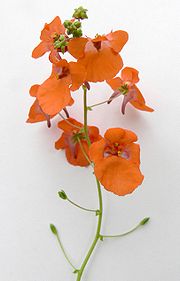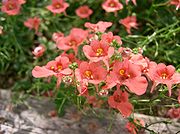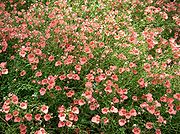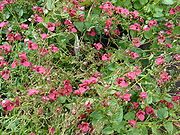.gif)
Diascia (plant)
Encyclopedia
Diascia is a genus
of around 70 species
of annual and perennial flowering herb
s of the Scrophulariaceae
family, native to southern Africa
, including South Africa
, Lesotho
and neighbouring areas.
The perennial species are found mainly in summer-rainfall areas such as the KwaZulu-Natal
Drakensberg
; about 50 species, mostly annuals, are found in the Western Cape
and Namaqualand
, winter rainfall areas.
Their common name is twinspur, in reference to the two (usually downward-pointing) spurs to be found on the back of the flower. These help to distinguish them from the similar (and closely related) genera Alonsoa
and Nemesia
. The spurs contain a special oil, which is collected in the wild by certain species of bees that appear to have coevolved with the plants, as they have unusually long forelegs for collecting the oil.
In gardens, diascia cultivar
s (mostly hybrids) have become extremely popular as colourful, floriferous, easily grown bedding plants in recent years.
 Surprisingly, the generic name (from the Greek di = two and askos = bag, pouch or sack) does not refer to the spurs, but to the two translucent sacs, or pouches, known as 'windows', found in the upper part of the corolla of the original type specimen, Diascia bergiana. Diascia species in the section Racemosae have similar windows, but in some species they merge into one. The windows may help oil-collecting bees to find the correct position within the corolla when gathering oil from the glands within the spurs.
Surprisingly, the generic name (from the Greek di = two and askos = bag, pouch or sack) does not refer to the spurs, but to the two translucent sacs, or pouches, known as 'windows', found in the upper part of the corolla of the original type specimen, Diascia bergiana. Diascia species in the section Racemosae have similar windows, but in some species they merge into one. The windows may help oil-collecting bees to find the correct position within the corolla when gathering oil from the glands within the spurs.
.
Rediviva neliana, a widespread species, collects from at least 12 species of Diascia, but in general, few different diascia species grow together in the same locality. As a result, local populations of R. neliana have been found to differ from each other, as each has developed legs that match the spur length of the diascias that are available to them in that locality. This indicates that local populations of R. neliana are coevolving with the flowers on which they depend.
, England. From 1985 he raised hundreds of hybrid seedlings, from which several excellent cultivar
s have been selected and named. He increased the colour range to include shades of apricot, pink, coral, lilac, red and white. Other nurseries and breeders have continued to build on his pioneering work.
Several species and cultivars have been given the Award of Garden Merit
by the British Royal Horticultural Society
. The AGM includes a hardiness
rating: most have been rated as intermediate between H3 (hardy outside in some regions or particular situations or which, while usually grown outside in summer, needs frost-free protection in winter – e.g. dahlias) and H4 (hardy throughout the British Isles).



Genus
In biology, a genus is a low-level taxonomic rank used in the biological classification of living and fossil organisms, which is an example of definition by genus and differentia...
of around 70 species
Species
In biology, a species is one of the basic units of biological classification and a taxonomic rank. A species is often defined as a group of organisms capable of interbreeding and producing fertile offspring. While in many cases this definition is adequate, more precise or differing measures are...
of annual and perennial flowering herb
Herb
Except in botanical usage, an herb is "any plant with leaves, seeds, or flowers used for flavoring, food, medicine, or perfume" or "a part of such a plant as used in cooking"...
s of the Scrophulariaceae
Scrophulariaceae
Scrophulariaceae, the figwort family, are a family of flowering plants. The plants are annual or perennial herbs with flowers with bilateral or rarely radial symmetry. Members of the Scrophulariaceae have a cosmopolitan distribution, with the majority found in temperate areas, including...
family, native to southern Africa
Africa
Africa is the world's second largest and second most populous continent, after Asia. At about 30.2 million km² including adjacent islands, it covers 6% of the Earth's total surface area and 20.4% of the total land area...
, including South Africa
South Africa
The Republic of South Africa is a country in southern Africa. Located at the southern tip of Africa, it is divided into nine provinces, with of coastline on the Atlantic and Indian oceans...
, Lesotho
Lesotho
Lesotho , officially the Kingdom of Lesotho, is a landlocked country and enclave, surrounded by the Republic of South Africa. It is just over in size with a population of approximately 2,067,000. Its capital and largest city is Maseru. Lesotho is a member of the Commonwealth of Nations. The name...
and neighbouring areas.
The perennial species are found mainly in summer-rainfall areas such as the KwaZulu-Natal
KwaZulu-Natal
KwaZulu-Natal is a province of South Africa. Prior to 1994, the territory now known as KwaZulu-Natal was made up of the province of Natal and the homeland of KwaZulu....
Drakensberg
Drakensberg
The Drakensberg is the highest mountain range in Southern Africa, rising to in height. In Zulu, it is referred to as uKhahlamba , and in Sesotho as Maluti...
; about 50 species, mostly annuals, are found in the Western Cape
Western Cape
The Western Cape is a province in the south west of South Africa. The capital is Cape Town. Prior to 1994, the region that now forms the Western Cape was part of the much larger Cape Province...
and Namaqualand
Namaqualand
Namaqualand is an arid region of Namibia and South Africa, extending along the west coast over and covering a total area of 170,000 square miles/440,000 km². It is divided by the lower course of the Orange River into two portions - Little Namaqualand to the south and Great Namaqualand to the...
, winter rainfall areas.
Their common name is twinspur, in reference to the two (usually downward-pointing) spurs to be found on the back of the flower. These help to distinguish them from the similar (and closely related) genera Alonsoa
Alonsoa
Alonsoa is a genus of 12 species of flowering plants in the family Scrophulariaceae, the figwort family. The genus includes both herbaceous and shrubby species....
and Nemesia
Nemesia (plant)
Nemesia is a genus of annuals, perennials and sub-shrubs which are native to Africa. A range of hybrids of species in this genus are commonly cultivated.Species include:...
. The spurs contain a special oil, which is collected in the wild by certain species of bees that appear to have coevolved with the plants, as they have unusually long forelegs for collecting the oil.
In gardens, diascia cultivar
Cultivar
A cultivar'Cultivar has two meanings as explained under Formal definition. When used in reference to a taxon, the word does not apply to an individual plant but to all those plants sharing the unique characteristics that define the cultivar. is a plant or group of plants selected for desirable...
s (mostly hybrids) have become extremely popular as colourful, floriferous, easily grown bedding plants in recent years.
Etymology

Description
Most diascia species are short-growing, straggling plants, reaching no more than 30–45 cm in height, although Diascia rigescens can reach 60 cm, and the rather similar D. personata (with which it is often confused) up to 120 cm or so. Some diascias spread by means of stolons, others produce multiple lax stems from a single crown. The flowers are borne in loose terminal racemes. The corolla is five-lobed, and normally pink or rose coloured in the perennial species most commonly seen in cultivation. Dark purplish patches of oil glands may make the flowers of some species appear bicoloured.Species
(From IPNI)- Diascia aliciae Hiern
- Diascia alonzoides Benth.
- Diascia anastrepta Hilliard & B.L.Burtt
- Diascia ausana Dinter
- Diascia austromontana K.E.Steiner
- Diascia avasmontana Dinter
- Diascia barberae Hook.f.
- Diascia batteniana K.E.Steiner
- Diascia bergiana Benth.
- Diascia bergiana Ecklon ex Hiern
- Diascia bergiana Link & Otto
- Diascia bicolor K.E.Steiner
- Diascia burchellii Benth.
- Diascia capensis Britten
- Diascia capsularis Benth.
- Diascia cardiosepala Hiern
- Diascia cordata N.E.Br.
- Diascia cuneata E.Mey. ex Benth.
- Diascia decipiens K.E.Steiner
- Diascia denticulata Benth.
- Diascia dielsiana Schltr. ex Hiern
- Diascia diffusa Benth.
- Diascia dissecta Hiern
- Diascia dissimulans Hilliard & B.L.Burtt
- Diascia elegans Hiern
- Diascia ellaphieae K.E.Steiner
- Diascia elongata Benth.
- Diascia engleri Diels
- Diascia esterhuyseniae K.E.Steiner
- Diascia expolita Hiern
- Diascia fetcaniensis Hilliard & B.L.Burtt
- Diascia flanaganii Hiern
- Diascia fragrans K.E.Steiner
- Diascia glandulosa Phillips
- Diascia gracilis Schltr.
- Diascia heterandra Benth.
- Diascia hetrandra Benth.
- Diascia hexensis K.E.Steiner
- Diascia humilis K.E.Steiner
- Diascia insignis K.E.Steiner
- Diascia integerrima E.Mey. ex Benth.
- Diascia jonantha Dinter
- Diascia karasmontana Dinter
- Diascia lewisiae K.E.Steiner
- Diascia lilacina Hilliard & B.L.Burtt
- Diascia longicornis Druce
- Diascia macowanii Hiern
- Diascia macrophylla Spreng.
- Diascia macrophylla Benth.
- Diascia maculata K.E.Steiner
- Diascia megathura Hilliard & B.L.Burtt
- Diascia minutiflora Hiern
- Diascia mollis Hilliard & B.L.Burtt
- Diascia moltenensis Hiern
- Diascia monasca Hiern
- Diascia montana Spreng.
- Diascia namaquensis Hiern
- Diascia nana Diels
- Diascia nemophiloides Benth.
- Diascia nodosa K.E.Steiner
- Diascia nutans Diels
- Diascia pachyceras E.Mey. ex Benth.
- Diascia parviflora Benth.
- Diascia patens Thunb. Grant ex Fourc.
- Diascia pentheri Schltr.
- Diascia personata Hilliard & B.L.Burtt
- Diascia purpurea N.E.Br.
- Diascia racemulosa Benth.
- Diascia ramosa Scott-Elliot
- Diascia rigescens E.Mey. ex Benth.
- Diascia rotundifolia Hiern
- Diascia rudolphi Hiern
- Diascia runcinata E.Mey. ex Benth.
- Diascia sacculata Benth.
- Diascia scullyi Hiern
- Diascia sinuata Druce
- Diascia stachyoides Schltr. ex Hiern
- Diascia stricta Hilliard & B.L.Burtt
- Diascia tanyceras E.Mey. ex Benth.
- Diascia thunbergiana Spreng.
- Diascia transkeiana Hilliard & B.L.Burtt
- Diascia tugelensis Hilliard & B.L.Burtt
- Diascia tysonii Hiern
- Diascia unilabiata Benth.
- Diascia veronicoides Schltr.
Coevolution with Rediviva bees
The two spurs found on the back of a diascia flower (from which it gets the common name twinspur) contain a special oil, which is collected in the wild by at least 8 species of bees of the genus Rediviva. The bees appear to have coevolved with the plants, as the females have developed unusually long, hairy forelegs with which they collect the oil from diascia spurs to feed their larvae (and sometimes to line their nests with). The spurs vary in average length from 5.3mm to as much as 13.9mm, mainly between species (although those of D. capsularis can vary widely between populations); the bees' forelegs vary similarly. The spurs of Diascia longicornis are about 25mm in length, but the existence of a suitably equipped pollinator, Rediviva emdeorum, with forelegs of the same length, was only confirmed in the 1980s. Rediviva longimanus has also been observed pollinating D. longicornis in the Western CapeWestern Cape
The Western Cape is a province in the south west of South Africa. The capital is Cape Town. Prior to 1994, the region that now forms the Western Cape was part of the much larger Cape Province...
.
Rediviva neliana, a widespread species, collects from at least 12 species of Diascia, but in general, few different diascia species grow together in the same locality. As a result, local populations of R. neliana have been found to differ from each other, as each has developed legs that match the spur length of the diascias that are available to them in that locality. This indicates that local populations of R. neliana are coevolving with the flowers on which they depend.
Garden uses
Diascias have become extremely popular worldwide as bedding plants, suitable for hanging baskets, window boxes and other containers, as well as rockeries and the fronts of herbaceous borders. This explosion of interest is largely thanks to the breeding work done by the late Hector Harrison of Appleby, North LincolnshireAppleby, North Lincolnshire
Appleby is a small village in North Lincolnshire, England. It lies about 5 km to the north-east of Scunthorpe, on the B1207.Appleby population in the 2001 census returns is shown as 597....
, England. From 1985 he raised hundreds of hybrid seedlings, from which several excellent cultivar
Cultivar
A cultivar'Cultivar has two meanings as explained under Formal definition. When used in reference to a taxon, the word does not apply to an individual plant but to all those plants sharing the unique characteristics that define the cultivar. is a plant or group of plants selected for desirable...
s have been selected and named. He increased the colour range to include shades of apricot, pink, coral, lilac, red and white. Other nurseries and breeders have continued to build on his pioneering work.
Several species and cultivars have been given the Award of Garden Merit
Award of Garden Merit
The Award of Garden Merit, or AGM, is an award made to garden plants by the British Royal Horticultural Society after a period of assessment by the appropriate committees of the Society...
by the British Royal Horticultural Society
Royal Horticultural Society
The Royal Horticultural Society was founded in 1804 in London, England as the Horticultural Society of London, and gained its present name in a Royal Charter granted in 1861 by Prince Albert...
. The AGM includes a hardiness
Hardiness (plants)
Hardiness of plants describe their ability to survive adverse growing conditions. It is usually limited to discussions of climatic adversity. Thus a plant's ability to tolerate cold, heat, drought, flooding, or wind are typically considered measurements of hardiness. Hardiness of plants is defined...
rating: most have been rated as intermediate between H3 (hardy outside in some regions or particular situations or which, while usually grown outside in summer, needs frost-free protection in winter – e.g. dahlias) and H4 (hardy throughout the British Isles).
Species
Among the species most commonly grown in gardens are:- Diascia fetcaniensis
- D. integerrima AGM H3–4
- D. rigescens AGM H3
- D. vigilis AGM H3
Cultivars
The cultivars commonly grown in gardens include:


- 'Appleby Apricot'
- Diascia barberae 'Belmore Beauty'
- 'Blackthorn Apricot' AGM H3–4
- 'Fisher's Flora'
- 'Ruby Field' AGM H3–4
- BLUE BONNET
- CORAL BELLE AGM H3–4
- Flying Colours Series
- FLYING COLOURS APPLEBLOSSOM, FLYING COLOURS APRICOT, FLYING COLOURS CORAL, FLYING COLOURS RED
- ICE CRACKER
- ICE CREAM
- 'Jacqueline's Joy'
- 'Joyce's Choice' AGM H3–4
- 'Katherine Sharman'
- 'Lady Valerie' AGM H3–4
- 'Lilac Belle' AGM H3–4
- 'Lilac Mist' AGM H3–4
- LITTLE DANCER
- LITTLE TANGO
- PINK PANTHER
- RED ACE
- REDSTART
- 'Rupert Lambert' AGM H3–4
- 'Salmon Supreme'
- 'Twinkle'
- Whisper Series
- WHISPER APRICOT IMPROVED, WHISPER CRANBERRY RED, WHISPER PUMPKIN, WHISPER TANGERINE, WHISPER WHITE
- Wink Series
- WINK GARNET

